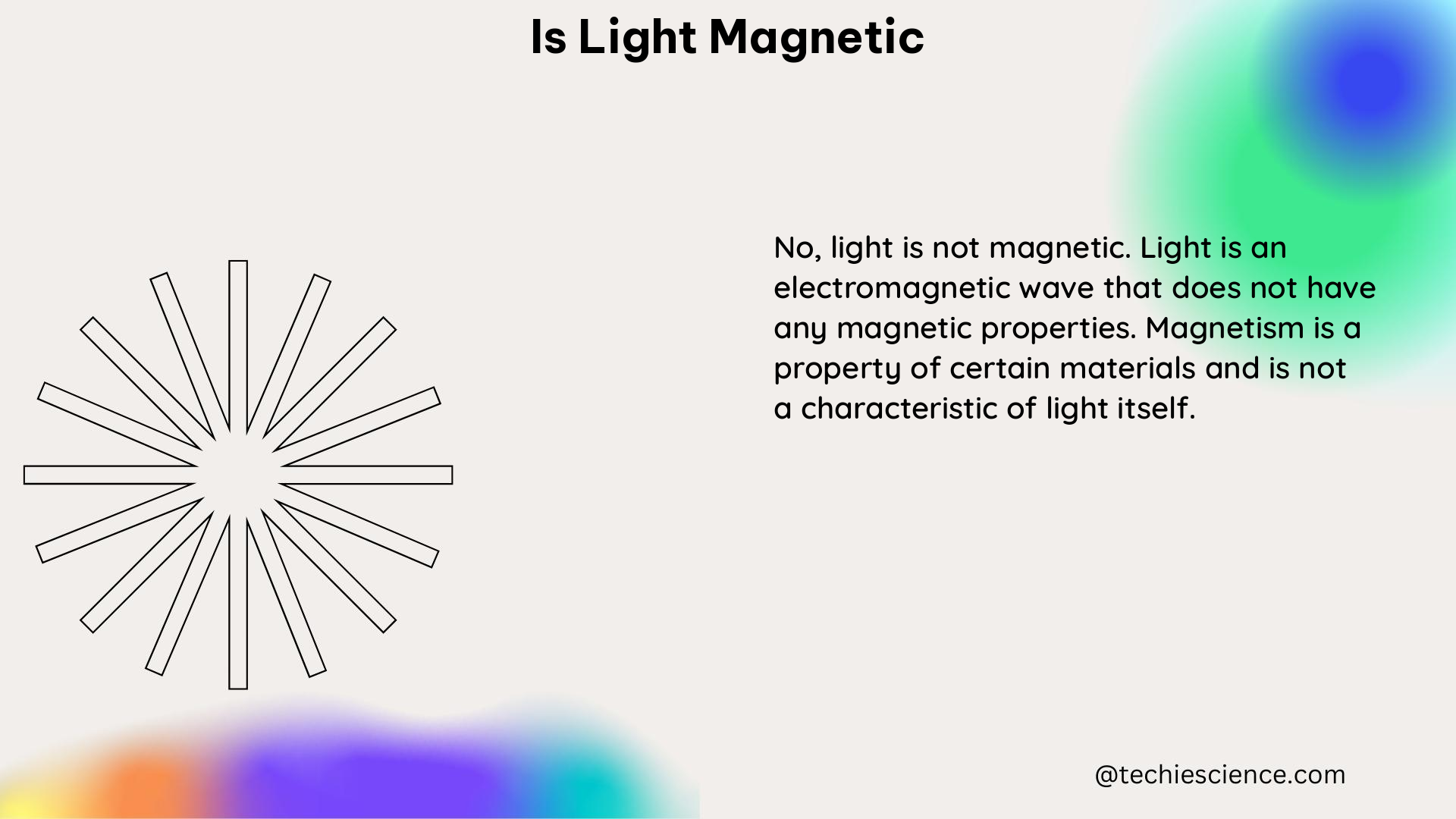Light is indeed magnetic, and this property is a fundamental aspect of its nature as an electromagnetic wave. The magnetic component of light waves is weaker than the electric component, but it can still be detected and measured under certain conditions.
Measuring the Magnetism of Light
One way to measure the magnetism of light is by using a tiny, metallic probe that interacts strongly with the magnetic field of light waves trapped in a type of semiconductor “box” called a photonic crystal microcavity. This setup can be used to measure the high-frequency magnetic properties of individual nano-scale objects or to map the magnetic field inside so-called metamaterials that can control light in new ways.
Photonic Crystal Microcavity
A photonic crystal microcavity is a type of semiconductor structure that can trap and confine light waves. The magnetic field of the trapped light waves can be detected and measured using a small metallic probe. This technique allows researchers to study the high-frequency magnetic properties of individual nano-scale objects or to map the magnetic field inside metamaterials.
The key features of a photonic crystal microcavity are:
- Photonic Crystal Structure: The microcavity is made of a photonic crystal, which is a periodic arrangement of materials with different refractive indices. This structure can control the propagation of light waves.
- Microcavity: The photonic crystal contains a small, localized region or “cavity” where light waves can be trapped and confined.
- High-Q Factor: The microcavity has a high quality (Q) factor, meaning that the trapped light waves can oscillate for a long time with minimal energy loss.
By placing a small metallic probe inside the microcavity, researchers can measure the magnetic field of the trapped light waves. This technique allows for the study of the high-frequency magnetic properties of individual nano-scale objects or the mapping of the magnetic field inside metamaterials.
Metamaterials and Light Magnetism
Metamaterials are artificial materials that can be engineered to have unique electromagnetic properties, including the ability to control the propagation of light in unusual ways. In metamaterials, the magnetic component of light can play a significant role in the interaction between light and the material.
Metamaterials often contain small components, such as metal rings, that are tailored to have an enhanced response to magnetic fields. When light interacts with these metamaterials, the magnetic component of the light can cause the electrons in the material to “swirl” in a way that is typically 10,000 times weaker than the “shaking” action from the electric field.
However, in metamaterials, this magnetic interaction can be amplified, allowing for the bending of light in unusual ways. This property of metamaterials has led to the development of devices such as super-lenses and invisibility cloaks, which rely on the manipulation of the magnetic component of light.
The Magnetic Component of Light

The magnetic component of light is a fundamental aspect of its nature as an electromagnetic wave. While the magnetic component is weaker than the electric component, it can still be detected and measured using specialized techniques and equipment.
Electromagnetic Wave Theory
Light is an electromagnetic wave, which means that it consists of oscillating electric and magnetic fields that are perpendicular to each other and to the direction of propagation. The relationship between the electric and magnetic fields is described by Maxwell’s equations, which are the fundamental equations of electromagnetism.
According to electromagnetic wave theory, the electric and magnetic fields of a light wave are related by the following equation:
B = (E/c) sin(kx - ωt)
Where:
– B is the magnetic field strength
– E is the electric field strength
– c is the speed of light
– k is the wavenumber
– ω is the angular frequency
– t is time
– x is the position along the direction of propagation
This equation shows that the magnetic field of a light wave is proportional to the electric field, with the constant of proportionality being 1/c, the inverse of the speed of light.
Magnetic Field Strength
The strength of the magnetic field in a light wave is typically much weaker than the strength of the electric field. The ratio of the magnetic field strength to the electric field strength is given by:
B/E = 1/c = 3.33 × 10^-9 T/(V/m)
This means that for a typical electric field strength of 1 V/m in a light wave, the corresponding magnetic field strength would be only about 3.33 nT (nanoTeslas).
Despite this relatively weak magnetic component, it can still be detected and measured using specialized techniques, such as the use of a tiny, metallic probe in a photonic crystal microcavity, as discussed earlier.
Implications of Light Magnetism
The magnetism of light has important implications for our understanding of light and its interactions with matter. While the magnetic component is weaker than the electric component, it can still play a significant role in certain situations, such as in the behavior of metamaterials.
Metamaterial Applications
Metamaterials, which can be engineered to have unique electromagnetic properties, often rely on the magnetic component of light to achieve their desired effects. By tailoring the response of the material to the magnetic field of light, researchers can create devices that can bend light in unusual ways, leading to the development of super-lenses, invisibility cloaks, and other novel applications.
Fundamental Physics
The magnetism of light is also a fundamental aspect of its nature as an electromagnetic wave. Understanding the relationship between the electric and magnetic fields of light is crucial for our understanding of electromagnetism and the behavior of light in various media and environments.
Measurement Techniques
The ability to measure the magnetic component of light using specialized techniques, such as the use of a metallic probe in a photonic crystal microcavity, has also opened up new avenues for research and exploration. These techniques allow researchers to study the high-frequency magnetic properties of individual nano-scale objects and to map the magnetic field inside metamaterials, leading to a deeper understanding of the behavior of light at the nanoscale.
Conclusion
In summary, light is indeed magnetic, and this property is a fundamental aspect of its nature as an electromagnetic wave. While the magnetic component of light is weaker than the electric component, it can still be detected and measured using specialized techniques and equipment. The magnetism of light has important implications for our understanding of light and its interactions with matter, particularly in the context of metamaterials and their applications. As our understanding of light magnetism continues to evolve, we can expect to see further advancements in the field of photonics and the development of new technologies that harness the unique properties of light.
References
- Electromagnetic Waves – The Physics Hypertextbook: https://physics.info/em-waves/
- Probably a dumb question but why is light called electromagnetic …: https://www.reddit.com/r/AskPhysics/comments/13z0ert/probably_a_dumb_question_but_why_is_light_called/
- Light and Magnets… and Gravity | Physics Van | Illinois: https://van.physics.illinois.edu/ask/listing/2009
- Measuring the Magnetism of Light – Physics Magazine: https://physics.aps.org/story/v26/st13

Hi,
I am Megha B R, I have completed my Post-Graduation in Solid State Physics and pursuing B. Ed. I am a Physics enthusiast. As an Academic writer, my goal is to reach the readers in a simplified manner through my articles.
Let’s connect through LinkedIn-